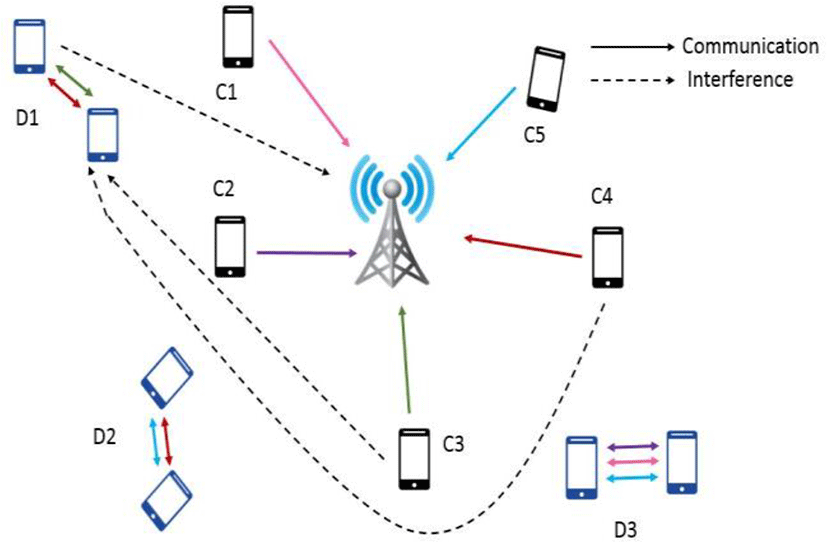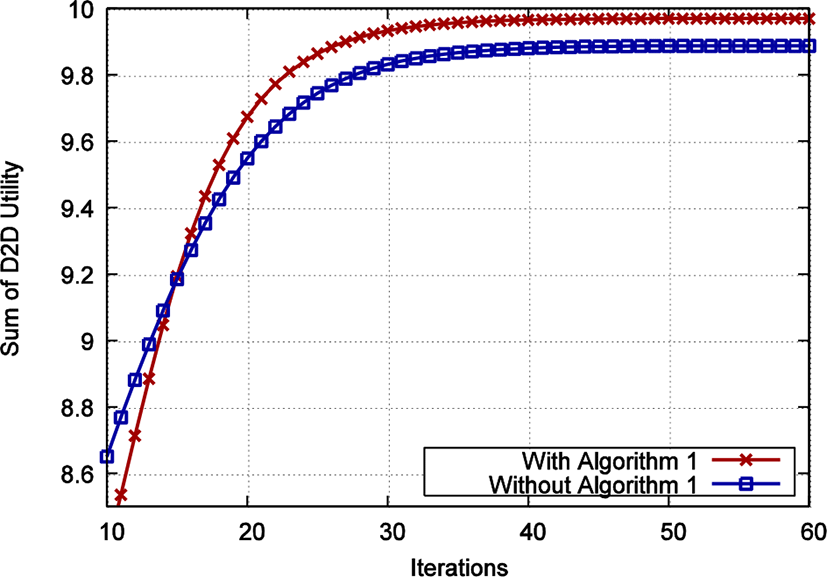I. INTRODUCTION
Currently, due to an increasing number of communication devices, current cellular network will be burdened [1]. To reduce the burden from cellular network, Device-to-device (D2D) communication that allows direct communication between nearby mobile devices is considered as a new key technology to improve the performance of current network [2], [3]. D2D communication can operate under overlaying mode or underlaying mode [3]. In this paper, we focus on underlaying mode where the D2D communication shares the same licensed band of cellular network to increase the efficiency of spectrum usage.
The coexistence of D2D communications and cellular communications under the same licensed band generates harmful interference. Therefore, the interferences need to be properly managed. Here, we limit the interferences caused by both cellular networks and D2D communications should be smaller than predetermined threshold. In addition, to provide more capacity to the D2D communication, a D2D pair is allowed to reuse multiple channels of cellular network.
In this paper, we propose an algorithm to allocate the channels and power to D2D communications such that the interference from D2D communications to cellular networks as well as from the cellular networks to the D2D communication are guaranteed.
II. SYSTEM MODEL
We consider uplink scenario with multiple D2D pairs, multiple cellular users (CUs) and an evolved Node B (eNB). We assume the channel and transmission power employed by the CUs have been decided by the eNB. The sets of CUs and the channels are combined and denoted as C = {1, 2, … , i, … ,C} while D2D pairs are defined as D = {1, 2, … , j, … ,D}. Besides that, we also assume that each UE is equipped with multiple antennas, thus able to transmit over multiple channels. As shown in Figure 1, we allow a CU to share its channel with multiple D2D pairs while one D2D pair can reuse multiple channels of CUs. The multiple CUs that share channels with the D2D pair form a group with the D2D pair denoted as Sj. Taking D2D pair D1 for example, as illustrate in Figure 1, D1 reuses the channels of CUs C3 and C4, forming group S1. Here, D1 receiver suffers the interference from C3 and C4, and at the same time, eNB is also exposed to the interference from D1.

Hence, we consider two interference power constraints for the system. Let hie, hjj be the channel gain between the CU C i and eNB, channel gain between D2D transmitter and receiver D j. Let hij, hje be the channel gain between CU C i to D2D D receiver j, channel gain between D2D transmitter D j and eNB. We denote pi as the transmission power of the CU C i, while pij as the transmission power of D2D transmitter D j when using channel C i
-
Interference power constraint at D2D receiver: For each D2D receiver D j, the total interferences cause by the CUs in the group should not be more than the threshold IcM.
-
Interference power constraint at cellular network: For each CU C i, the total interferences cause by D2D pairs in the channel C i should not be more than the threshold IdM.
In addition, we also consider another power constraint in this paper.
-
Transmit power constraint at D2D: The total transmission power of each D2D transmitter over multiple channels should not exceed its maximum power.
Our objectives in this paper are to address three problems: i) how the eNB controls the interference between D2D communication and cellular networks; ii) how to decide the channels to be used by each D2D pair; iii) how the D2D distributes its power over the multi-channel to maximize its utility. To solve these problems, we propose an approach from game theory perspective as shown in the following.
III. INTERFERENCE COORDINATION STRATEGIES
In this section, we propose a method to decide the CUs that will share channels with a D2D pair as well control the interference from the cellular networks to D2D communication in which the interference from CUs to D2D is limited to certain threshold as in (1). We assume that eNB knows the location of CUs and D2D pairs. We describe the specific algorithm as steps in the following part.
We determine the initial possible channels based on the interference-limited area approach. We define the area as an area in which interference-to-signal (ISR) ratio at the D2D receiver ISRj is lower than the predetermined threshold γd. Hence, the constraint for the area can be expressed as ISRj = pihij/p0hjj≤γd, where p0 is defined as initial transmission power of any D2D pair. From the constraint we can find the area in which D2D pair cannot reuse the channel of CU. The path-loss model is defined as hij = β · (dij)−α , where dij is the distance between CU C i and D2D receiver D j, β is the path-loss constant, and α is the path-loss exponent. By substituting this, the constraint is rewritten as
According to (4), the distance between D2D D j and CU C i should be more than to avoid huge interference from the CU. Therefore, D2D D j can only reuse the channels of CUs that has the distance more than threshold as in (4). For all the possible channels, D2D pair D j will form the initial coalition Sj.
To select the final channels to be used by the each D2D pair D j is to enable the D2D to update which channels to be used based on the interference caused by the CUs in Sj. Notice that, the proposed method is performed by the D2D pair locally. The interference power cause by each CU in Sjand total interference power cause by all the CUs in Sj are calculated. As in (1), if , D2D pair D j will delete the channel where the CU cause the biggest interference from its coalition. The whole process is expressed in Algorithm 1.
Channel allocation algorithm
-
Initial state:
-
Update coalition structure Sj:
REPEAT
In this section, we propose a solution from game theory perspective to optimally solve the problem on how D2D distributes its power over the multi-channel to maximize its utility as well as control the interference from the D2D communication to cellular network.
The interaction between the eNB and the D2D pair can be modeled by the Stackelberg game. Since we want to control the interference from D2D communication to cellular network, here the cellular network has more priority than the D2D communication. Therefore, it is natural to formulate the eNB as the leader, and the D2D pair as the follower. As leader, the eNB owns the channels and can charge the price for each D2D pair accessing to the channel to control the interference from D2D communication. The D2D pair needs to buy the channels to transmit data.
At the leader, the eNB collects the payment from all the D2D pairs in the network and adjusts the price to maximize its utility function. Let λi be the interference price charged by eNB to D2D pair for using channel C i, we define the utility function of the eNB as total profit by selling the channels.
The optimization problem for the leader is to set the charging price that maximizes its utility (5),
Since there are no coupling constraints among the sub-problem in (6), we can decompose the problem into C sub-problems as follows: for each CU C i, we solve:
For the follower, the utility function is its throughput minus the cost it pays for using the channels. Since the D2D pair D j reuses channels of multiple CUs in the coalition Sj as formed in section 3.1, the utility of D2D pair D j is given as
where No represents the additive white Gaussian noise (AWGN). The optimization problem for the follower is to set proper transmit power in each channel to maximize its utility (8) while guaranteeing the constraint (3).
The game can be solved by backward induction where the solution of the follower is derived first, follow by the leader solution.
The D2D pair wants to maximize its utility by allocate proper transmission power when using multi-channel. To provide closed form solution of pij,
The best response is solved by first-order derivative,
Let A = 1/(ln2hje), B = (pihij + No)/hjj, the solution of pij is
Using the solution (11), the set of D2D transmission power pij for channels in Sj is searched. Note that, as we limit the total pij as in constraint (3), the set must meet the constraint. Thus, for every set of transmission power, the constraint need to be checked. If the total pij in Sj meets the constraint in (3), the set of pij remains unchanged. However, if the total pijexceeds the constraint, the number of channels in Sj is reduced until the constraint is met. For example, if there are 3 elements of pij in Sj at first, it is reduced to 2 or 1, depends on which pij gives the best utility.
After getting the solution of transmission power from D2D pair D j as in (11), we substitute the power into the utility function of leader to find the optimal interference price. We have the Lagrange function for the leader optimization (7) as:
where v is the Lagrange multiplier. The dual function is given by maximizing the Lagrange function over λi . Substituting (11) into Lagrange function above and by taking the derivative of Lle over λi equal to zero, we have the solution of the price as follows:
The dual problem is defined by minimizing the dual function. We apply the sub-gradient method to find v iteratively [4]. The derivative of the dual function for the leader is given as . At each iteration t, we update the variable v as
where s is step size.
Here, we summarize the strategies for D2D pair and eNB for Stackelberg game in Algorithm 2.
Price-based power allocation algorithm
-
Find the price:
while Not converge (loop t) do
Calculate the optimal price λi as in (12).
end while
-
Find the set of optimal power pij in Sj as in (11).
-
Calculate utility of D2D in each channel:
-
Check the transmit power constraint (3):
then D2D pair update the set by deleting the element pij that give the least utility.
else the set remains.
end if
IV. RESULTS
In this section, we show the preliminary result of the proposed method. We consider a single circular cell environment with the D2D pairs and CUs randomly distributed in the cell area. We compare the sum utility of D2D pairs at Algorithm 2 after channel allocation algorithm (Algorithm 1) is performed with the sum utility of D2D pairs when only Algorithm 2 is performed without conducting Algorithm 1.
In the first case, as described in Section 3, the channels to be used by the D2D will be selected first, then the D2D pair will distribute its power over the selected channels while in the second case, the channels to be used by D2D pair are not selected in which all the channels can be used by the D2D pair. Thus, in second case, D2D pair distributes its power over all the channels.
Figure 2 shows the sum utility of two D2D pairs. As shown in the figure, after several iterations, the sum of D2D utility is higher when the channels to be used by D2D pair is selected using Algorithm 1 as the interferences from cellular network to the D2D communication is guaranteed.
V. Conclusion
In this paper, we propose interference-based channel allocation and Stackelberg game to jointly optimize the performance of D2D communication under multi-channel while guarantee the interference from cellular networks and D2D communication will not exceed the interference threshold. From the results, D2D communication performance is better when both Algorithm 1 and 2 are performed.
